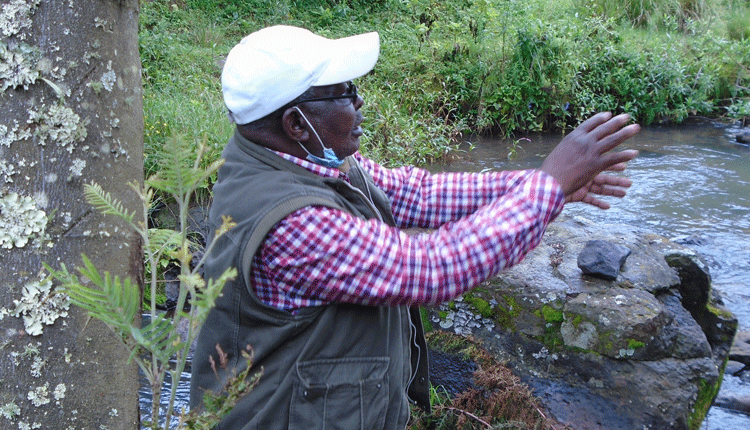Local association leads efforts in river restoration
By Milliam Murigi, September 28, 2021
When Joseph Mwaniki was an administrative officer in North Kinangop, Nyandarua county, he was so keen on environmental matters, ensuring he brought environmental crimes to near nonexistence.
However, when he retired in 1997 and left the town, things started changing. People started felling trees illegally and encroaching riparian land.
This led to the loss of biodiversity, pollution of the nearby Kitiri and Mkunga rivers, low water levels, competition, and conflicts among water users.
“I was surprised when one day I walked along those two rivers and their tributaries and I couldn’t find any standing tree.
People had encroached the riparian land, cut down all the trees, and were practising crop farming. Since I couldn’t do anything I walked back home with a heavy heart,” says the 78-year-old.
In 2006 Mkungi–Kitiri Water Resource Users Association (WRUA) was formed and Mwaniki was elected to lead it.
This is one of the WRUAs in the Lake Naivasha basin. WRUAs are community-based natural resources management institutions set up following the Integrated Water Resources Management framework.
They are the most local participatory governance structure currently in place managing tributaries of the Malewa river.
Nationally, WRUAs’ key objectives are to promote controlled and legal water use activities, good management practices that make efficient and sustainable use of water resources, safeguarding of environmental flows for downstream ecological demands and basic human needs, reduction of water use conflicts, and catchment conservation measures to improve water quantity and quality.

As the chairman, his first initiative was to reclaim the riparian land. Though it was not an easy task, he eventually, together with other group members, managed to do it.
After that, they were forced to plant trees to ensure the land doesn’t remain bare.
Since securing seedlings was a costly affair for the group, they decided to start their own seedling nursery, which also helps them earn some money to sustain the group.
“We started planting trees in 2007, but then we were doing very few trees. In 2012, we started mass planting and growing of trees. So far we have planted 35km of the intended 90km.”
Tree harvesting
He adds that their efforts were met with different challenges along the way with the main being people harvesting the trees even before they matured. Because of this, they had to go back to the drawing board and restrategise.
Luckily Worldwide Fund for Nature (WWF) came their way in 2018 through their Lake Naivasha Basin Afforestation project and they formed a partnership, which has been helping communities plant trees on their farms.
The main aim of this partnership is to work with communities and water users in the Lake Naivasha basin for the implementation of activities that will bring multiple livelihood benefits such as environmental restoration while providing other livelihood benefits to the communities and contributing to improved water quality and quantity in Lake Naivasha.
The partnership is being implemented in two ways; through woodlots and agroforestry. Since people there have large parcels of land, they started with woodlots.
Participants in this phase of the project were supposed to set aside an area entirely for trees.
For agroforestry, the project was looking for small-scale farmers. Here, farmers are expected to grow trees among or around food crops in their farms. So far about 2,400 acres have been planted.
“For this project, we pay for all the seedlings planted by farmers. Our aim is to establish 2,875 acres of new forest areas on farmlands and 288 acres of biodiversity area.
To help us achieve this, we are working with eight WRUAs across the entire basin,” said WWF-Kenya Naivasha Landscape Coordinator Caroline Njiru.
To ensure all trees are grown, they monitor them, and in case of mortality, they replace 10 per cent of the seedlings given.
Anything more than that is replaced by the participating farmer. Over 70 coordinators who support site selection, farmer registration, training, planting, and monitoring have been trained.
Mwaniki says the introduction of the own-farm initiative has helped as people are no longer going into the forest to cut down trees.
It has also seen trees planted on riparian land survive something which was impossible a few years ago.
“Water levels in the two rivers and their tributaries have gone up and quality has improved.
Today, this water is used for domestic use and it is very safe. I am always happy to see the water flow freely thus being able to meet the high demand for water against competing needs,” says Mwaniki.